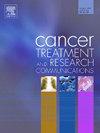Prognostic significance of lepidic component in invasive non-mucinous adenocarcinoma of the lung
IF 2.4
Q3 Medicine
引用次数: 0
Abstract
Objectives
Although radiologic ground-glass opacity (GGO) components are associated with favorable prognosis, limited evidence supports the prognostic significance of corresponding histologic lepidic components. This study aimed to evaluate the prognostic value of lepidic components in patients with surgically resected invasive non-mucinous lung adenocarcinoma at pathologic (p-) stages I to IIIA.
Materials and Methods
We retrospectively analyzed 352 patients who underwent resection for invasive non-mucinous adenocarcinoma between 2012 and 2016. Histopathologic features, CT findings, clinical characteristics, and outcomes were reviewed. True non-invasive lepidic components were distinguished from invasive lepidic-like proliferations.
Results
Lepidic-positive tumors (n = 226; 64%) were significantly associated with female sex, presence and higher ratio of GGO, EGFR mutations, lower p-stage, and absence of pleural, vascular, and lymphatic invasion. The 5-year recurrence-free survival rate was significantly higher in lepidic-positive than lepidic-negative tumors (89% vs. 47%, p < 0.001). Multivariate analysis identified the presence of lepidic components as an independent predictor of favorable prognosis (hazard ratio, 0.48; CI, 0.29–0.81; p = 0.0057). A lepidic component ≥10% was associated with favorable outcomes in p-stage IA and IB disease, regardless of exact percentage. Lepidic and GGO components showed a positive correlation and similar prognostic relevance.
Conclusions
Histologic lepidic and radiologic GGO components reflect less aggressive tumor behavior and may serve as favorable prognostic indicators in invasive non-mucinous lung adenocarcinoma.
肺浸润性非粘液腺癌中卵泡成分的预后意义
虽然放射学上的磨玻璃混浊(GGO)成分与良好的预后有关,但有限的证据支持相应的组织学上的透明成分对预后的意义。本研究旨在评估手术切除的侵袭性非黏液肺腺癌病理(p-)期I至IIIA期患者中leeptic成分的预后价值。材料与方法回顾性分析2012年至2016年间352例行侵袭性非粘液腺癌切除术的患者。我们回顾了组织病理特征、CT表现、临床特征和结果。真正的非侵入性鳞片成分与侵入性鳞片样增生区分开来。结果slepidi阳性肿瘤(n = 226;64%)与女性、GGO的存在和较高比例、EGFR突变、p期较低、胸膜、血管和淋巴浸润不存在显著相关。鳞片阳性肿瘤的5年无复发生存率明显高于鳞片阴性肿瘤(89%比47%,p < 0.001)。多因素分析发现,卵黄成分的存在是预后良好的独立预测因子(风险比0.48;CI 0.29-0.81; p = 0.0057)。在p期IA和IB疾病中,卵黄成分≥10%与有利结果相关,无论确切百分比如何。Lepidic和GGO成分呈正相关,与预后有相似的相关性。结论GGO的组织学指标和放射学指标反映肿瘤的侵袭性较低,可作为侵袭性非粘液肺腺癌的良好预后指标。
本文章由计算机程序翻译,如有差异,请以英文原文为准。
求助全文
约1分钟内获得全文
求助全文
来源期刊

Cancer treatment and research communications
Medicine-Oncology
CiteScore
4.30
自引率
0.00%
发文量
148
审稿时长
56 days
期刊介绍:
Cancer Treatment and Research Communications is an international peer-reviewed publication dedicated to providing comprehensive basic, translational, and clinical oncology research. The journal is devoted to articles on detection, diagnosis, prevention, policy, and treatment of cancer and provides a global forum for the nurturing and development of future generations of oncology scientists. Cancer Treatment and Research Communications publishes comprehensive reviews and original studies describing various aspects of basic through clinical research of all tumor types. The journal also accepts clinical studies in oncology, with an emphasis on prospective early phase clinical trials. Specific areas of interest include basic, translational, and clinical research and mechanistic approaches; cancer biology; molecular carcinogenesis; genetics and genomics; stem cell and developmental biology; immunology; molecular and cellular oncology; systems biology; drug sensitivity and resistance; gene and antisense therapy; pathology, markers, and prognostic indicators; chemoprevention strategies; multimodality therapy; cancer policy; and integration of various approaches. Our mission is to be the premier source of relevant information through promoting excellence in research and facilitating the timely translation of that science to health care and clinical practice.
 求助内容:
求助内容: 应助结果提醒方式:
应助结果提醒方式:


